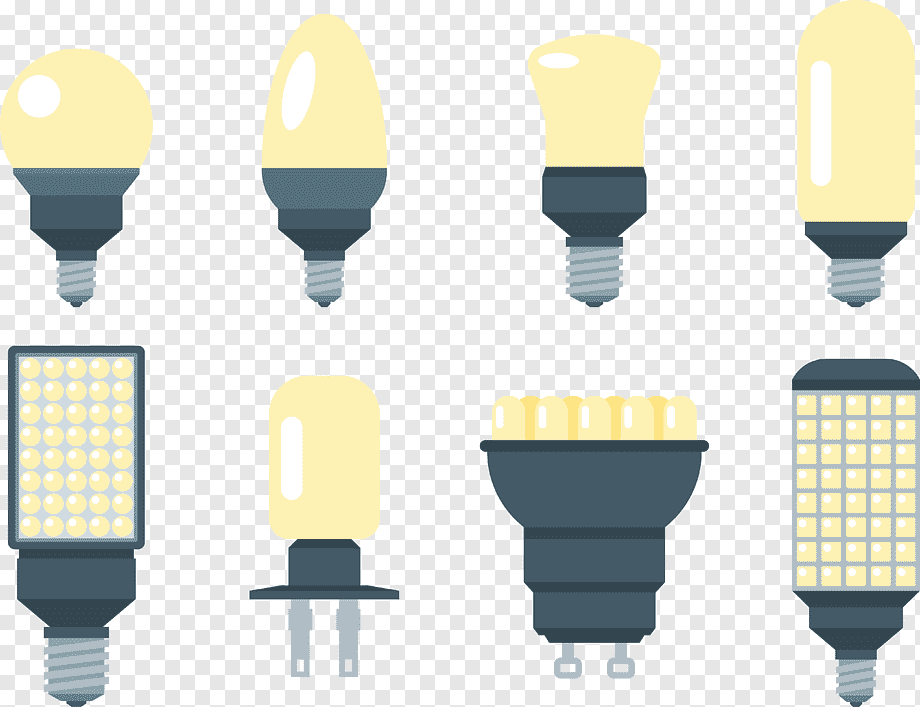


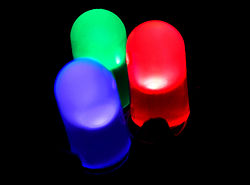
| مصابيح LED زرقاء وخضراء وحمراء في علبة منتشرة 5 مم | |
| مبدأ العمل | التألق الكهربائي |
|---|---|
| اخترع | H. J. Round (1907)[1] اوليج لوسيف (1927)[2] جيمس ر. بيارد (1961)[3] نيك هولونياك (1962)[4] |
| أول إنتاج | أكتوبر 1962 |
| تكوين دبوس | الأنود و الكاثود |
| رمز الكتروني | |
 أجزاء من الصمام التقليدي. تعمل الأسطح السفلية المسطحة للسندان والدعامة المدمجة داخل الإيبوكسي كمثبتات ، لمنع سحب الموصلات بقوة عن طريق الضغط الميكانيكي أو الاهتزاز
أجزاء من الصمام التقليدي. تعمل الأسطح السفلية المسطحة للسندان والدعامة المدمجة داخل الإيبوكسي كمثبتات ، لمنع سحب الموصلات بقوة عن طريق الضغط الميكانيكي أو الاهتزاز
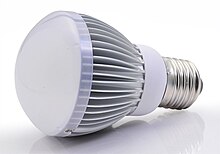
تحديث عصري على شكل لمبة مصباح LED مع الألمنيوم تقليل الحرارة، مشتعل منتشر قبة و برغي E27 قاعدة ، باستخدام مصدر طاقة مدمج يعمل عليه أنابيب الجهد
صورة مقربة لمصباح LED على السطح
الصمام الثنائي الباعث للضوء – Light-emitting diode
من ويكيبيديا
الصمام الثنائي الباعث للضوء (يؤدى) هو أشباه الموصلات مصدر ضوء التي ينبعث منها الضوء عندما تيار يتدفق من خلاله. الإلكترونات في إعادة توحيد أشباه الموصلات مع ثقوب الإلكترون، وإطلاق الطاقة في شكل الفوتونات. يتم تحديد لون الضوء (المقابل لطاقة الفوتونات) من خلال الطاقة اللازمة للإلكترونات لعبور فجوة الفرقة من أشباه الموصلات.[5] يتم الحصول على الضوء الأبيض باستخدام أشباه موصلات متعددة أو طبقة من الفوسفور الباعث للضوء على جهاز أشباه الموصلات.[6]
ظهرت كمكونات إلكترونية عملية في عام 1962 ، كانت أول مصابيح LED تنبعث منها كثافة منخفضة الأشعة تحت الحمراء (IR) ضوء.[7] تستخدم مصابيح الأشعة تحت الحمراء في جهاز التحكم الدوائر ، مثل تلك المستخدمة مع مجموعة متنوعة من الأجهزة الإلكترونية الاستهلاكية. كانت أول مصابيح LED للضوء المرئي منخفضة الكثافة ومحدودة باللون الأحمر. تتوفر مصابيح LED الحديثة عبر مرئي, فوق بنفسجي (UV) ، وأطوال موجات الأشعة تحت الحمراء ، مع إخراج ضوء عالٍ.
غالبًا ما تم استخدام مصابيح LED المبكرة كمصابيح مؤشر ، لتحل محل المصابيح المتوهجة الصغيرة ، وفي يعرض سبعة أجزاء. أنتجت التطورات الأخيرة مصابيح LED ذات إضاءة بيضاء عالية الإنتاج مناسبة لإضاءة الغرفة والمنطقة الخارجية. أدت مصابيح LED إلى شاشات وأجهزة استشعار جديدة ، في حين أن معدلات التبديل العالية لها مفيدة في تكنولوجيا الاتصالات المتقدمة.
تتمتع مصابيح LED بالعديد من المزايا مقارنة بمصادر الإضاءة المتوهجة ، بما في ذلك استهلاك أقل للطاقة ، وعمر أطول ، ومتانة جسدية محسنة ، وحجم أصغر ، وتحويل أسرع. تستخدم مصابيح LED في تطبيقات متنوعة مثل إضاءة الطيران, المصابيح الأمامية للسيارات، إعلان، إضاءة عامة, أشارات المرورومضات الكاميرا خلفية مضاءة, تنمو الأضواء البستانيةوالأجهزة الطبية.[8]
على عكس أ الليزر، الضوء المنبعث من LED ليس طيفيًا متماسك ولا حتى عالية أحادي اللون. ومع ذلك ، فإن الطيف ضيق بما فيه الكفاية بحيث يبدو أن عين الانسان نقي (مشبع) اللون.[9][10] على عكس معظم أنواع الليزر ، فإن إشعاعها ليس كذلك متماسك مكانيًا، لذلك لا يمكن أن تقترب من عالية جدا سطوع سمة من سمات الليزر.
التاريخ”
التاريخ
الاكتشافات والأجهزة المبكرة
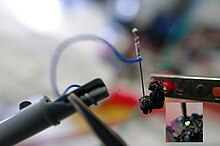
تلألؤ كهربائي أخضر من نقطة تلامس على بلورة SiC يعيد إنشائه مستديرالتجربة الأصلية من عام 1907.
التألق الكهربائي كظاهرة تم اكتشافها في عام 1907 من قبل المجرب البريطاني H. J. Round من مختبرات ماركونيباستخدام بلورة كربيد السيليكون و أ كاشف طولي القط.[11][12] المخترع الروسي اوليج لوسيف أبلغ عن إنشاء أول LED في عام 1927.[13] تم توزيع أبحاثه في المجلات العلمية السوفيتية والألمانية والبريطانية ، ولكن لم يتم استخدام هذا الاكتشاف عمليًا لعدة عقود.[14][15]
في عام 1936 ، جورج ديستريو لاحظ أنه يمكن إنتاج التألق الكهربي عندما كبريتيد الزنك يتم تعليق مسحوق (ZnS) في عازل ويتم تطبيق مجال كهربائي بديل عليه. غالبًا ما أشار ديسترياو في منشوراته إلى اللمعان باسم Losev-Light. عمل Destriau في مختبرات Madame ماري كوري، أيضًا من الرواد الأوائل في مجال التلألؤ مع البحث في الراديوم.[16][17]
المجرية خليج زولتان معا مع جيورجي زيجيتي إضاءة LED مسبقة في المجر في عام 1939 عن طريق تسجيل براءة اختراع لجهاز إضاءة يعتمد على SiC ، مع خيار على كربيد البورون ، الذي ينبعث منه أبيض أو أبيض مصفر أو أبيض مخضر اعتمادًا على الشوائب الموجودة.[18]
كيرت ليهوفيتشوشرح كارل أكاردو وإدوارد جامجوتشيان هذه المصابيح الأولى في عام 1951 باستخدام جهاز يستخدم SiC بلورات ذات مصدر حالي لبطارية أو مولد نبضي وبالمقارنة مع بلورة متغيرة نقية في عام 1953.[19][20]
روبن براونشتاين[21] من مؤسسة راديو أمريكا ذكرت عن انبعاث الأشعة تحت الحمراء من مركب الزرنيخ (GaAs) وسبائك أشباه الموصلات الأخرى في عام 1955.[22] لاحظ براونشتاين انبعاث الأشعة تحت الحمراء الناتج عن هياكل الصمام الثنائي البسيطة باستخدام أنتيمونيد الغاليوم (GaSb) ، GaAs ، فوسفيد الإنديوم (InP) و السيليكون والجرمانيوم (SiGe) السبائك في درجة حرارة الغرفة وعند 77كلفنز.
في عام 1957 ، أظهر براونشتاين كذلك أن الأجهزة البدائية يمكن استخدامها للاتصالات غير الراديوية عبر مسافة قصيرة. كما لاحظ كرومر[23] أنشأ Braunstein “… رابطًا بسيطًا للاتصالات الضوئية: تم استخدام الموسيقى الناشئة من مشغل التسجيل عبر إلكترونيات مناسبة لتعديل التيار الأمامي لصمام ثنائي GaAs. تم الكشف عن الضوء المنبعث بواسطة الصمام الثنائي PbS على بعد مسافة ما. تم تغذية هذه الإشارة في مكبر صوت وتشغيله بواسطة مكبر صوت. اعتراض الشعاع أوقف الموسيقى. لقد استمتعنا كثيرًا باللعب مع هذا الإعداد. ” تم إعداد هذا الإعداد مسبقًا لاستخدام مصابيح LED لـ الاتصال البصري التطبيقات.

1962 Texas Instruments SNX-100 GaAs LED الموجودة في علبة معدنية من الترانزستور TO-18
في سبتمبر 1961 ، أثناء العمل في شركة Texas Instruments في دالاس, تكساس, جيمس ر. بيارد واكتشف جاري بيتمان انبعاث ضوء الأشعة تحت الحمراء القريبة (900 نانومتر) من a نفق ديود كانوا قد شيدوا على ركيزة GaAs.[7] بحلول أكتوبر 1961 ، أظهروا كفاءة انبعاث ضوئي واقتران إشارة بين باعث ضوء تقاطع pn من GaAs وكاشف ضوئي لأشباه الموصلات المعزول كهربائياً.[24] في 8 أغسطس 1962 ، قدم Biard و Pittman براءة اختراع بعنوان “أشباه الموصلات المشعة الصمام الثنائي” بناءً على النتائج التي توصلوا إليها ، والتي وصفت مادة الزنك المنتشرة السندات الإذنية تقاطع LED مع تباعد الكاثود الاتصال للسماح بانبعاث ضوء الأشعة تحت الحمراء بكفاءة تحيز للأمام. بعد تحديد أولوية عملهم بناءً على الدفاتر الهندسية التي سبقت الطلبات المقدمة ج. مختبرات RCA مختبرات البحث آي بي إم مختبرات البحث مختبرات بيلو و مختبر لينكولن في معهد ماساتشوستس للتكنولوجيا، ال مكتب براءات الاختراع الأمريكي أصدر المخترعين براءة اختراع للديود الباعث للضوء بالأشعة تحت الحمراء (براءة الاختراع الأمريكية الولايات المتحدة 3293513) ، أول LED عملي.[7] مباشرة بعد تسجيل براءة الاختراع ، شركة Texas Instruments (TI) بدأت مشروع لتصنيع ثنائيات الأشعة تحت الحمراء. في أكتوبر 1962 ، أعلنت TI عن أول منتج تجاري LED (SNX-100) ، والذي استخدم بلورة GaAs نقية لإصدار ناتج ضوئي 890 نانومتر.[7] في أكتوبر 1963 ، أعلنت TI عن أول مصباح LED تجاري نصف كروي ، SNX-110.[25]
تم عرض أول طيف مرئي (أحمر) LED بواسطة نيك هولونياك الابن في 9 أكتوبر 1962 بينما كان يعمل جنرال إلكتريك في سيراكيوز ، نيويورك.[26] أبلغ هولونياك وبيفاكوا عن هذا الصمام في المجلة رسائل الفيزياء التطبيقية في 1 ديسمبر 1962.[27][28] جورج كرافورد,[29] طالب دراسات عليا سابق في Holonyak ، اخترع أول LED أصفر وحسن سطوع المصابيح الحمراء والبرتقالية الحمراء بعامل عشرة في 1972.[30] في عام 1976 ، صمم T. P. Pearsall أول مصابيح LED عالية السطوع وعالية الكفاءة لاتصالات الألياف الضوئية عن طريق اختراع مواد جديدة من أشباه الموصلات تتكيف بشكل خاص مع الأطوال الموجية لنقل الألياف الضوئية.[31]
التطوير التجاري الأولي
تم استخدام أول مصابيح LED تجارية ذات طول موجي مرئي بشكل شائع كبديل لـ ساطع و مصابيح مؤشر النيون، و في يعرض سبعة أجزاء,[32] أولاً في المعدات باهظة الثمن مثل معدات اختبار المختبرات والإلكترونيات ، ثم لاحقًا في الأجهزة مثل الآلات الحاسبة وأجهزة التلفزيون والراديو والهواتف ، وكذلك الساعات (انظر قائمة استخدامات الإشارةحتى عام 1968 ، كانت مصابيح LED المرئية والأشعة تحت الحمراء مكلفة للغاية ، في حدود دولار أمريكي$200 لكل وحدة ، وبالتالي لم يكن لها استخدام عملي يذكر.[33]
هيوليت باكارد (HP) كانت تعمل في البحث والتطوير (R&D) على مصابيح LED عملية بين عامي 1962 و 1968 ، بواسطة فريق بحث تحت إشراف Howard C. Borden و Gerald P. Pighini و محمد محمد عطالله في HP Associates و مختبرات HP.[34] خلال هذا الوقت ، أطلق عطا الله برنامج تحقيق في علوم المواد مركب الزرنيخ (GaAs) ، فوسفيد زرنيخيد الغاليوم (GaAsP) و زرنيخيد الإنديوم (InAs) الأجهزة في HP ،[35] وتعاونوا مع شركة مونسانتو على تطوير منتجات LED الأولى القابلة للاستخدام.[36] كانت أول منتجات LED القابلة للاستخدام هي منتجات HP عرض الصمام ومونسانتو مصباح مؤشر LED، تم إطلاق كلاهما في عام 1968.[36] كانت مونسانتو أول مؤسسة تنتج كميات كبيرة من مصابيح LED المرئية ، باستخدام GaAsP في عام 1968 لإنتاج مصابيح LED حمراء مناسبة للمؤشرات.[33] عرضت شركة Monsanto سابقًا تزويد HP بـ GaAsP ، لكن HP قررت تطوير GaAsP الخاص بها.[33] في فبراير 1969 ، قدمت Hewlett-Packard مؤشر رقمي طراز HP 5082-7000 ، وهو أول جهاز LED يستخدم دارة متكاملة (المدمجة دائرة LED) تقنية.[34] كانت أول شاشة LED ذكية ، وكانت ثورة في عرض رقمي التكنولوجيا ، لتحل محل أنبوب Nixie وأصبح أساسًا لشاشات LED اللاحقة.[37]
ترك عطا الله HP وانضم إليها فيرتشايلد أشباه الموصلات في عام 1969.[38] كان نائب الرئيس والمدير العام لقسم الميكروويف والإلكترونيات الضوئية ،[39] منذ إنشائها في مايو 1969 حتى نوفمبر 1971.[40] واصل عمله على مصابيح LED ، مقترحًا إمكانية استخدامها أضواء المؤشر و القراء البصرية في عام 1971.[41] في السبعينيات من القرن الماضي ، تم إنتاج أجهزة LED الناجحة تجاريًا بأقل من خمسة سنتات لكل منها بواسطة Fairchild Optoelectronics. تستخدم هذه الأجهزة المركبة رقائق أشباه الموصلات ملفقة مع عملية مستوية (طورت بواسطة جان هورني,[42][43] على أساس أتالا التخميل السطحي طريقة[44][45]). مزيج من المعالجة المستوية لـ تصنيع الرقائق ومبتكرة التعبئة والتغليف أساليب مكنت الفريق في فيرتشايلد بقيادة رائد الإلكترونيات الضوئية توماس براندت من تحقيق التخفيضات المطلوبة في التكلفة.[46] يستمر منتجو LED في استخدام هذه الأساليب.[47]

شاشة LED من أ TI-30 آلة حاسبة علمية (1978 م) تستخدم العدسات البلاستيكية لزيادة حجم الرقم المرئي
كانت مصابيح LED الحمراء المبكرة ساطعة بدرجة كافية لاستخدامها كمؤشرات فقط ، حيث لم يكن ناتج الضوء كافياً لإضاءة المنطقة. كانت القراءات في الآلات الحاسبة صغيرة جدًا بحيث تم بناء عدسات بلاستيكية فوق كل رقم لجعلها مقروءة. في وقت لاحق ، أصبحت الألوان الأخرى متاحة على نطاق واسع وظهرت في الأجهزة والمعدات.
تم تعبئة مصابيح LED المبكرة في علب معدنية مشابهة لتلك الموجودة في الترانزستورات ، مع نافذة زجاجية أو عدسة لإخراج الضوء. يتم تعبئة مؤشرات LED الحديثة في علب بلاستيكية شفافة مقولبة ، أنبوبي أو مستطيل الشكل ، وغالبًا ما تكون ملونة لتتناسب مع لون الجهاز. قد تكون أجهزة الأشعة تحت الحمراء مصبوغة لحجب الضوء المرئي. تم تكييف حزم أكثر تعقيدًا لتبديد الحرارة بكفاءة في مصابيح LED عالية الطاقة. تعمل مصابيح LED المثبتة على السطح على تقليل حجم العبوة. المصابيح المعدة للاستخدام مع الألياف البصرية يمكن تزويد الكابلات بموصل بصري.
الصمام الأزرق
أول LED أزرق بنفسجي يستخدم مخدر بالمغنيسيوم نيتريد الغاليوم تم صنعه في جامعة ستانفورد في عام 1972 من قبل Herb Maruska و Wally Rhines ، طلاب الدكتوراه في علوم وهندسة المواد.[48][49] في ذلك الوقت كان ماروسكا في إجازة من مختبرات RCA، حيث تعاون مع جاك بانكوف في الأعمال ذات الصلة. في عام 1971 ، بعد عام من مغادرة ماروسكا إلى ستانفورد ، أظهر زملاؤه في RCA Pankove و Ed Miller أول تلألؤ كهربائي أزرق من نيتريد الغاليوم المشبع بالزنك ، على الرغم من أن الجهاز اللاحق الذي صنعه Pankove and Miller ، أول صمام ثنائي باعث للضوء من نيتريد الغاليوم ، انبعث ضوء اخضر.[50][51] في عام 1974 مكتب براءات الاختراع الأمريكي منح أستاذ Maruska و Rhines و Stanford David Stevenson براءة اختراع لعملهم في عام 1972 (براءة اختراع أمريكية US3819974 أ). اليوم ، لا تزال المنشطات المغنيسيوم لنتريد الغاليوم هي الأساس لجميع المصابيح الزرقاء التجارية و ثنائيات الليزر. في أوائل السبعينيات ، كانت هذه الأجهزة قاتمة للغاية للاستخدام العملي ، وتباطأ البحث في أجهزة نيتريد الغاليوم.
في أغسطس 1989 ، كري قدم أول LED أزرق متوفر تجاريًا استنادًا إلى فجوة الحزمة غير المباشرة أشباه الموصلات ، كربيد السيليكون (SiC).[52] تتمتع مصابيح SiC LED بكفاءة منخفضة للغاية ، لا تزيد عن 0.03٪ ، ولكنها تنبعث في الجزء الأزرق من طيف الضوء المرئي.[53][54]
في أواخر الثمانينيات ، اختراقات رئيسية في GaN فوقي النمو و نوع p منشطات[55] بشرت في العصر الحديث للأجهزة الكهروضوئية القائمة على GaN. بناء على هذا الأساس ، ثيودور مصطفى حصل في جامعة بوسطن على براءة اختراع طريقة لإنتاج مصابيح LED زرقاء عالية السطوع باستخدام عملية جديدة من خطوتين في عام 1991.[56]
بعد ذلك بعامين ، في عام 1993 ، تم عرض مصابيح LED زرقاء عالية السطوع بواسطة شوجي ناكامورا من شركة Nichia باستخدام عملية نمو نيتريد الغاليوم.[57][58][59] بالتوازي، إيسامو أكاساكي و هيروشي أمانو في ناغويا كانوا يعملون على تطوير المهم GaN ترسيب على ركائز الياقوت ومظاهرة المنشطات من النوع p من GaN. أحدث هذا التطور الجديد ثورة في إضاءة LED مصادر الضوء الأزرق عالية الطاقة عملي ، مما يؤدي إلى تطوير تقنيات مثل بلو راي[بحاجة لمصدر].
حصل ناكامورا على جائزة عام 2006 جائزة الألفية للتكنولوجيا لاختراعه.[60]ناكامورا هيروشي أمانو و إيسامو أكاساكي حصلوا على جائزة نوبل في الفيزياء في عام 2014 لاختراع الصمام الأزرق.[61] في عام 2015 ، قضت محكمة أمريكية بأن ثلاث شركات انتهكت براءة اختراع مصطفى السابقة ، وأمرتهم بدفع رسوم ترخيص لا تقل عن 13 مليون دولار أمريكي.[62]
في عام 1995، ألبرتو باربيري في ال جامعة كارديف قام المختبر (GB) بالتحقيق في كفاءة وموثوقية مصابيح LED عالية السطوع وأظهر “اتصال شفاف” باستخدام LED أكسيد القصدير الإنديوم (ITO) على (AlGaInP / GaAs).
في عام 2001[63] و 2002 ،[64] عمليات النمو نيتريد الغاليوم (GaN) مصابيح LED قيد التشغيل السيليكون تم عرضها بنجاح. في يناير 2012 ، اوسرام أظهر مصابيح InGaN عالية الطاقة المزروعة على ركائز السيليكون تجاريًا ،[65] و GaN-on-silicon LEDs قيد الإنتاج في بليسي أشباه الموصلات. اعتبارًا من عام 2017 ، تستخدم بعض الشركات المصنعة كربيد السيليكون كركيزة لإنتاج LED ، ولكن الياقوت أكثر شيوعًا ، حيث يحتوي على أكثر الخصائص تشابهًا لنتريد الغاليوم ، مما يقلل من الحاجة إلى نقش رقاقة الياقوت (تُعرف الرقاقات المنقوشة باسم epi الرقائق). سامسونج، ال جامعة كامبريدجو و توشيبا إجراء بحث حول GaN على Si LEDs. توقفت Toshiba عن البحث ، ربما بسبب انخفاض الإنتاجية.[66][67][68][69][70][71][72] يختار البعض التصلب ، وهو أمر صعب السيليكون، في حين أن آخرين ، مثل جامعة كامبريدج ، يختارون بنية متعددة الطبقات ، من أجل تقليل عدم تطابق الشبكة (البلورية) ونسب التمدد الحراري المختلفة ، من أجل تجنب تكسير رقاقة LED عند درجات حرارة عالية (على سبيل المثال أثناء التصنيع) ، تقليل توليد الحرارة وزيادة كفاءة الإضاءة. يمكن إجراء Epitaxy (أو الياقوت المنقوش) باستخدام الطباعة الحجرية بالنانو.[73][74][75][76][77][78][79] غالبًا ما يتم إيداع GaN باستخدام طور التبخر المعدني العضوي (MOCVD) ، ويستخدم أيضًا يغادر.
المصابيح البيضاء واختراق الإضاءة
على الرغم من أنه يمكن إنشاء الضوء الأبيض باستخدام مصابيح LED فردية حمراء وخضراء وزرقاء ، إلا أن هذا يؤدي إلى عرض ألوان رديء ، حيث يتم بث ثلاثة نطاقات ضيقة فقط من الأطوال الموجية للضوء. سرعان ما تبع تحقيق مصابيح LED الزرقاء عالية الكفاءة تطوير الأول الصمام الأبيض. في هذا الجهاز أ ص
3ال
5ا
12: م (المعروف باسم “ياج“أو Ce: YAG phosphor) السيريوم ينتج طلاء الفوسفور المخدر الضوء الأصفر من خلاله ضوئي. يظهر مزيج هذا اللون الأصفر مع الضوء الأزرق المتبقي أبيض للعين. باستخدام مختلف الفوسفور ينتج الضوء الأخضر والأحمر من خلال التألق. يُنظر إلى المزيج الناتج من الأحمر والأخضر والأزرق على أنه ضوء أبيض ، مع تحسن تجسيد اللون مقارنة بالأطوال الموجية من تركيبة الفوسفور LED / YAG الزرقاء.[بحاجة لمصدر]
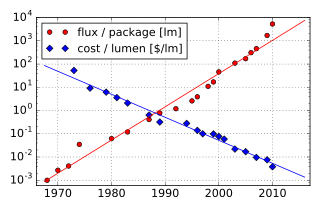
رسم توضيحي لـ قانون هايتس، يظهر تحسنًا في ناتج الضوء لكل LED بمرور الوقت ، بمقياس لوغاريتمي على المحور الرأسي
كانت مصابيح LED البيضاء الأولى باهظة الثمن وغير فعالة. ومع ذلك ، فقد زاد ناتج الضوء من مصابيح LED أضعافا مضاعفة. تم نشر أحدث الأبحاث والتطوير من قبل الشركات المصنعة اليابانية مثل باناسونيكو و نيتشيا، ومن قبل الشركات المصنعة الكورية والصينية مثل سامسونجو Kingsun وغيرهم. تم استدعاء هذا الاتجاه في زيادة الإنتاج قانون هايتس بعد الدكتور رولاند هايتس.[80]
ارتفع ناتج الضوء وكفاءة المصابيح الزرقاء وشبه فوق البنفسجية وانخفضت تكلفة الأجهزة الموثوقة. أدى ذلك إلى مصابيح LED ذات إضاءة بيضاء عالية الطاقة نسبيًا للإضاءة ، والتي تحل محل الإضاءة المتوهجة والفلورية.[81][82]
تم عرض المصابيح البيضاء التجريبية في عام 2014 لإنتاج 303 لومن لكل واط من الكهرباء (lm / w) ؛ يمكن أن يستمر بعضها حتى 100000 ساعة.[83][84] ومع ذلك ، تتمتع مصابيح LED المتاحة تجاريًا بكفاءة تصل إلى 223 لومن / ث اعتبارًا من عام 2018.[85][86][87] تم تحقيق رقم قياسي سابق قدره 135lm / w بواسطة Nichia في عام 2010.[88] بالمقارنة مع المصابيح المتوهجة ، فهذه زيادة كبيرة في الكفاءة الكهربائية ، وعلى الرغم من أن شراء مصابيح LED أغلى ، إلا أن التكلفة الإجمالية أرخص بكثير من المصابيح المتوهجة.[89]
يتم تغليف رقاقة LED داخل قالب صغير من البلاستيك الأبيض. يمكن تغليفه باستخدام الراتنج (البولي يوريثين– أساسه) أو سيليكون أو إيبوكسي يحتوي على (مسحوق) فوسفور الياج السيريوم المشبع. بعد السماح للمذيبات بالتبخر ، غالبًا ما يتم اختبار مصابيح LED ووضعها على أشرطة من أجلها معدات التنسيب SMT للاستخدام في إنتاج المصباح الكهربائي LED. يتم إجراء التغليف بعد الفحص ، والتقطيع ، ونقل القالب من الرقاقة إلى العبوة ، وربط الأسلاك أو تركيب رقاقة الوجه ، ربما باستخدام أكسيد القصدير الإنديوم، موصل كهربائي شفاف. في هذه الحالة ، يتم توصيل سلك (أسلاك) الربط بفيلم ITO الذي تم ترسيبه في مصابيح LED. تستخدم بعض مصابيح الإضاءة “الفوسفور عن بعد” LED غطاء بلاستيكيًا واحدًا مع فوسفور YAG لعدة مصابيح LED زرقاء ، بدلاً من استخدام طبقات الفوسفور على المصابيح البيضاء ذات رقاقة واحدة.[بحاجة لمصدر]
فيزياء إنتاج الضوء وانبعاثه
في الصمام الثنائي الباعث للضوء ، ينتج عن إعادة تركيب الإلكترونات وثقوب الإلكترون في أشباه الموصلات الضوء (سواء كان الأشعة تحت الحمراء أو المرئية أو فوق البنفسجية) ، وهي عملية تسمى “التألق الكهربائي“. الطول الموجي للضوء يعتمد على الطاقة فجوة الفرقة من أشباه الموصلات المستخدمة. نظرًا لأن هذه المواد تحتوي على مؤشر انكسار عالٍ ، فإن ميزات تصميم الأجهزة مثل الطلاء البصري الخاص وشكل القالب مطلوبة لإصدار الضوء بكفاءة.[بحاجة لمصدر]
الألوان
بواسطة اختيار مواد أشباه الموصلات المختلفة، يمكن صنع مصابيح LED أحادية اللون تنبعث منها الضوء في نطاق ضيق من الأطوال الموجية من الأشعة تحت الحمراء القريبة عبر الطيف المرئي وفي نطاق الأشعة فوق البنفسجية. عندما تصبح الأطوال الموجية أقصر ، بسبب فجوة النطاق الكبيرة لهذه أشباه الموصلات ، يزداد جهد التشغيل لمصباح LED.
الأزرق والأشعة فوق البنفسجية

أزرق المصابيح
| فيديو خارجي |
|---|
تحتوي المصابيح الزرقاء على منطقة نشطة تتكون من واحد أو أكثر من InGaN آبار الكم محصور بين طبقات سميكة من الجاليوم ، تسمى طبقات الكسوة. من خلال تغيير جزء In / Ga النسبي في الآبار الكمومية InGaN ، يمكن أن يتنوع انبعاث الضوء نظريًا من البنفسجي إلى الكهرماني.
نيتريد الغاليوم الألومنيوم يمكن استخدام (AlGaN) لكسر Al / Ga المتنوع لتصنيع طبقات الكسوة وطبقات الآبار الكمومية لمصابيح LED فوق البنفسجية ، ولكن هذه الأجهزة لم تصل بعد إلى مستوى الكفاءة والنضج التكنولوجي لأجهزة InGaN / GaN الزرقاء / الخضراء. إذا تم استخدام GaN غير المخلوط في هذه الحالة لتشكيل طبقات البئر الكمومية النشطة ، فإن الجهاز يصدر ضوءًا قريبًا من الأشعة فوق البنفسجية بطول موجة يبلغ حوالي 365 نانومتر. تعد مصابيح LED الخضراء المصنعة من نظام InGaN / GaN أكثر كفاءة وإشراقًا من مصابيح LED الخضراء التي يتم إنتاجها باستخدام أنظمة المواد غير النيتريد ، لكن الأجهزة العملية لا تزال تظهر كفاءة منخفضة جدًا للتطبيقات عالية السطوع.[بحاجة لمصدر]
مع AlGaN و AlGaInN، حتى الأطوال الموجية الأقصر يمكن تحقيقها. بواعث الأشعة فوق البنفسجية القريبة بأطوال موجية تتراوح بين 360 و 395 نانومتر هي بالفعل رخيصة الثمن وغالبًا ما يتم مواجهتها ، على سبيل المثال ، ضوء أسود استبدال المصباح لفحصالتزوير العلامات المائية للأشعة فوق البنفسجية في المستندات والأوراق البنكية ، ول علاج الأشعة فوق البنفسجية. في حين أن الثنائيات ذات الطول الموجي الأقصر أغلى بكثير ، إلا أنها متاحة تجارياً لأطوال موجية تصل إلى 240 نانومتر.[90] بما أن حساسية الكائنات الدقيقة للضوء تتطابق تقريبًا مع طيف الامتصاص لـ الحمض النووي، مع ذروة تبلغ حوالي 260 نانومتر ، من المتوقع انبعاث LED للأشعة فوق البنفسجية في 250-270 نانومتر في أجهزة التطهير والتعقيم المحتملة. أظهرت الأبحاث الحديثة أن مصابيح UVA المتوفرة تجاريًا (365 نانومتر) هي بالفعل أجهزة تطهير وتعقيم فعالة.[91]تم الحصول على أطوال موجات UV-C في المعامل باستخدام نيتريد الألومنيوم (210 نانومتر) ،[92] نيتريد البورون (215 نانومتر)[93][94] و الماس (235 نانومتر).[95]
أبيض
هناك طريقتان أساسيتان للإنتاج أبيض الثنائيات الباعثة للضوء. واحد هو استخدام المصابيح الفردية التي تنبعث منها ثلاثة الألوان الأساسية—أحمر وأخضر وأزرق — ثم امزج كل الألوان لتكوين ضوء أبيض. والآخر هو استخدام مادة الفوسفور لتحويل الضوء أحادي اللون من الضوء الأزرق أو الأشعة فوق البنفسجية إلى ضوء أبيض واسع الطيف ، على غرار مصباح الفلورسنت. الفوسفور الأصفر السيريوم-مخدر ياج بلورات معلقة في العبوة أو مطلية بمصباح LED. يتسبب فوسفور YAG هذا في ظهور مصابيح LED البيضاء باللون الأصفر عند إيقاف التشغيل ، وتسمح المسافة بين البلورات بمرور بعض الضوء الأزرق. بدلاً من ذلك ، قد تستخدم مصابيح LED البيضاء فوسفورًا آخر مثل المنغنيز (IV) المخدر فلوروسيليكات البوتاسيوم (PFS) أو الفوسفور الهندسي الآخر. يساعد PFS في توليد الضوء الأحمر ، ويستخدم بالاقتران مع فوسفور Ce: YAG التقليدي. في مصابيح LED التي تحتوي على فوسفور PFS ، يمر بعض الضوء الأزرق عبر الفوسفور ، ويقوم فوسفور Ce: YAG بتحويل الضوء الأزرق إلى ضوء أخضر وأحمر ، ويقوم فوسفور PFS بتحويل الضوء الأزرق إلى ضوء أحمر. يمكن التحكم في درجة حرارة لون LED عن طريق تغيير تركيز الفوسفور.[96][97][98]
تم تصميم “بياض” الضوء الناتج ليناسب العين البشرية. بسبب metamerism، من الممكن وجود أطياف مختلفة تمامًا تظهر بيضاء. قد يختلف مظهر الأشياء المضاءة بهذا الضوء باختلاف الطيف. هذه هي قضية عرض اللون ، منفصلة تمامًا عن درجة حرارة اللون. يمكن أن يظهر جسم برتقالي أو سماوي بلون خاطئ وأغمق كثيرًا لأن LED أو الفوسفور لا ينبعث منهما الطول الموجي الذي يعكسه. تستخدم أفضل مصابيح LED لعرض الألوان مزيجًا من الفوسفور ، مما يؤدي إلى تقليل الكفاءة وتحسين عرض الألوان.[بحاجة لمصدر]
أنظمة RGB

منحنيات طيفية مجمعة لمصابيح LED ذات الحالة الصلبة باللون الأزرق والأصفر والأخضر وعالية السطوع. FWHM يبلغ عرض النطاق الترددي الطيفي حوالي 24-27 نانومتر لجميع الألوان الثلاثة.

RGB LED
إن خلط المصادر الحمراء والخضراء والزرقاء لإنتاج ضوء أبيض يحتاج إلى دوائر إلكترونية للتحكم في مزج الألوان. نظرًا لأن مصابيح LED لها أنماط انبعاث مختلفة قليلاً ، فقد يتغير توازن اللون اعتمادًا على زاوية الرؤية ، حتى لو كانت مصادر RGB في حزمة واحدة ، لذلك نادرًا ما تستخدم ثنائيات RGB لإنتاج إضاءة بيضاء. ومع ذلك فهذه الطريقة لها العديد من التطبيقات بسبب مرونة خلط الألوان المختلفة ،[99] ومن حيث المبدأ ، تتمتع هذه الآلية أيضًا بكفاءة كمية أعلى في إنتاج الضوء الأبيض.[100]
هناك عدة أنواع من المصابيح البيضاء متعددة الألوان: د-, ثلاثيو و رباعي اللون المصابيح البيضاء. العديد من العوامل الرئيسية التي تلعب بين هذه الأساليب المختلفة تشمل استقرار اللون ، تجسيد اللون القدرة والفعالية المضيئة. في كثير من الأحيان ، تعني الكفاءة الأعلى تجسيدًا أقل للون ، مما يوفر مفاضلة بين فعالية الإضاءة وتجسيد اللون. على سبيل المثال ، تتمتع مصابيح LED البيضاء ثنائية اللون بأفضل فعالية إنارة (120 lm / W) ، ولكنها أقل قدرة على عرض اللون. على الرغم من أن مصابيح LED البيضاء الرباعية اللون تتمتع بقدرة ممتازة على عرض الألوان ، إلا أنها غالبًا ما تكون ذات كفاءة إضاءة ضعيفة. توجد مصابيح LED بيضاء ثلاثية الألوان في المنتصف ، وتتميز بكفاءة الإضاءة الجيدة (> 70 lm / W) وإمكانية عرض الألوان العادلة.[بحاجة لمصدر]
يتمثل أحد التحديات في تطوير مصابيح LED خضراء أكثر كفاءة. الحد الأقصى النظري لمصابيح LED الخضراء هو 683 لومن لكل واط ، ولكن اعتبارًا من عام 2010 ، تجاوز عدد قليل من مصابيح LED الخضراء حتى 100 لومن لكل واط. تقترب المصابيح الزرقاء والحمراء من حدودها النظرية.[بحاجة لمصدر]
توفر مصابيح LED متعددة الألوان أيضًا وسيلة جديدة لتكوين ضوء بألوان مختلفة. معظم ألوان يمكن إدراكها يمكن تشكيلها عن طريق خلط كميات مختلفة من ثلاثة ألوان أساسية. هذا يسمح بالتحكم الدقيق في اللون الديناميكي. ومع ذلك ، فإن هذا النوع من طاقة انبعاث LED يضمحل أضعافا مضاعفة مع ارتفاع درجة الحرارة ،[101]مما أدى إلى تغيير جوهري في استقرار اللون. مثل هذه المشاكل تمنع الاستخدام الصناعي. لا يمكن أن توفر مصابيح LED متعددة الألوان بدون الفوسفور عرضًا جيدًا للألوان لأن كل مؤشر LED هو مصدر ضيق النطاق. تعتبر مصابيح LED التي لا تحتوي على الفوسفور ، حلًا ضعيفًا للإضاءة العامة ، أفضل حل لشاشات العرض ، سواء كانت الإضاءة الخلفية لشاشات الكريستال السائل أو وحدات البكسل القائمة على LED المباشرة.
يعد تعتيم مصدر LED متعدد الألوان ليتناسب مع خصائص المصابيح المتوهجة أمرًا صعبًا لأن اختلافات التصنيع والعمر ودرجة الحرارة تغير ناتج قيمة اللون الفعلية. لمحاكاة مظهر المصابيح المتوهجة الخافتة ، قد يتطلب نظام تغذية مرتدة مع مستشعر ألوان لمراقبة اللون والتحكم فيه بشكل فعال.[102]
المصابيح القائمة على الفوسفور

طيف لمصباح LED أبيض يُظهر الضوء الأزرق المنبعث مباشرةً من مؤشر LED القائم على GaN (الذروة عند حوالي 465 نانومتر) والنطاق العريض الأكبر ستوكس تحول الضوء المنبعث من السقف3+: فوسفور YAG ، الذي ينبعث عند 500-700 نانومتر تقريبًا
تتضمن هذه الطريقة طلاء مصابيح LED ذات لون واحد (معظمها مصابيح LED زرقاء مصنوعة من InGaN) مع الفوسفور بألوان مختلفة لتشكيل الضوء الأبيض ؛ تسمى مصابيح LED الناتجة المصابيح البيضاء المستندة إلى الفوسفور أو الفوسفور المحولة (pcLEDs).[103] يخضع جزء من الضوء الأزرق لإزاحة ستوكس ، والتي تحوله من أطوال موجية أقصر إلى أطوال أطول. اعتمادًا على لون LED الأصلي ، يتم استخدام فوسفور ملون مختلف. يؤدي استخدام العديد من طبقات الفوسفور ذات الألوان المميزة إلى توسيع الطيف المنبعث ، مما يرفع بشكل فعال من مؤشر تجسيد اللون (CRI).[104]
تتعرض مصابيح LED القائمة على الفوسفور لخسائر في الكفاءة بسبب فقد الحرارة من تحول ستوكس وكذلك القضايا الأخرى المتعلقة بالفوسفور. تعتمد كفاءاتها المضيئة مقارنةً بمصابيح LED العادية على التوزيع الطيفي لإخراج الضوء الناتج والطول الموجي الأصلي للـ LED نفسه. على سبيل المثال ، تتراوح الفعالية المضيئة لمصباح LED أبيض نموذجي قائم على الفوسفور YAG من 3 إلى 5 أضعاف الفعالية المضيئة لمصباح LED الأزرق الأصلي بسبب حساسية العين البشرية الأكبر للأصفر من الأزرق (كما هو موضح في وظيفة اللمعان). نظرًا لبساطة التصنيع ، لا تزال طريقة الفوسفور هي الطريقة الأكثر شيوعًا لصنع مصابيح LED بيضاء عالية الكثافة. تصميم وإنتاج مصدر الضوء أو تركيبات الإضاءة باستخدام باعث أحادي اللون مع تحويل الفوسفور أبسط وأرخص من المركب RGB النظام ، ويتم تصنيع غالبية مصابيح LED البيضاء عالية الكثافة الموجودة حاليًا في السوق باستخدام تحويل ضوء الفوسفور.[بحاجة لمصدر]
من بين التحديات التي يتم مواجهتها لتحسين كفاءة مصادر الضوء الأبيض القائمة على LED تطوير فوسفور أكثر كفاءة. اعتبارًا من عام 2010 ، لا يزال الفوسفور الأصفر الأكثر كفاءة هو فوسفور YAG ، مع فقد أقل من 10٪ في ستوكس. الخسائر التي تُعزى إلى الخسائر البصرية الداخلية بسبب إعادة الامتصاص في رقاقة LED وفي عبوة LED نفسها تمثل عادةً 10٪ إلى 30٪ أخرى من فقدان الكفاءة. حاليًا ، في مجال تطوير الفوسفور LED ، يتم بذل الكثير من الجهد لتحسين هذه الأجهزة لإنتاج إضاءة أعلى ودرجات حرارة تشغيل أعلى. على سبيل المثال ، يمكن رفع الكفاءة من خلال تكييف تصميم حزمة أفضل أو باستخدام نوع أكثر ملاءمة من الفوسفور. تُستخدم عملية الطلاء المطابقة بشكل متكرر لمعالجة مشكلة اختلاف سماكة الفوسفور.[بحاجة لمصدر]
تغلف بعض مصابيح LED البيضاء المستندة إلى الفوسفور مصابيح LED الزرقاء InGaN داخل إبوكسي مطلي بالفوسفور. بدلاً من ذلك ، يمكن إقران LED مع فسفور بعيد ، قطعة بولي كربونات مسبقة التشكيل مغلفة بمادة الفوسفور. توفر الفوسفور البعيد مزيدًا من الضوء المنتشر ، وهو أمر مرغوب فيه للعديد من التطبيقات. تصميمات الفوسفور البعيدة هي أيضًا أكثر تسامحًا مع الاختلافات في طيف انبعاثات LED. مادة الفوسفور الأصفر الشائعة هي السيريوم–مخدر عقيق الإيتريوم الألومنيوم (م3+: YAG).[بحاجة لمصدر]
يمكن أيضًا صنع المصابيح البيضاء بواسطة طلاء مصابيح LED قريبة من الأشعة فوق البنفسجية (NUV) بمزيج من الكفاءة العالية اليوروبيوم– الفوسفور الذي ينبعث منه اللون الأحمر والأزرق ، بالإضافة إلى النحاس وكبريتيد الزنك المشبع بالألمنيوم (ZnS: Cu ، Al) الذي ينبعث منه اللون الأخضر. هذه طريقة مماثلة للطريقة مصابيح فلورسنت عمل. هذه الطريقة أقل كفاءة من مصابيح LED الزرقاء المزودة بفسفور YAG: Ce ، حيث أن تحول Stokes أكبر ، لذلك يتم تحويل المزيد من الطاقة إلى حرارة ، ولكنها تنتج ضوءًا بخصائص طيفية أفضل ، مما يجعل اللون أفضل. نظرًا لارتفاع الناتج الإشعاعي لمصابيح LED فوق البنفسجية مقارنةً بالمصابيح الزرقاء ، توفر كلتا الطريقتين سطوعًا مشابهًا. مصدر القلق هو أن ضوء الأشعة فوق البنفسجية قد يتسرب من مصدر ضوء معطل ويسبب ضررًا للعين البشرية أو الجلد.[بحاجة لمصدر]
المصابيح البيضاء الأخرى
طريقة أخرى مستخدمة لإنتاج مصابيح LED التجريبية للضوء الأبيض لا تستخدم الفوسفور على الإطلاق وتستند إليها homoepitaxially نابعة سيلينيد الزنك (ZnSe) على ركيزة ZnSe التي تنبعث منها في نفس الوقت الضوء الأزرق من منطقتها النشطة والضوء الأصفر من الركيزة.[105]
يتم استخدام نمط جديد من الرقاقات المكونة من نيتريد الغاليوم على السيليكون (GaN-on-Si) لإنتاج مصابيح LED بيضاء باستخدام رقائق سيليكون 200 مم. هذا يتجنب التكلفة النموذجية الياقوت المادة المتفاعلة بأحجام صغيرة نسبيًا بحجم 100 أو 150 مم.[106] يجب أن يقترن جهاز الياقوت بجهاز تجميع يشبه المرآة لعكس الضوء الذي كان من الممكن أن يضيع. كان من المتوقع أنه منذ عام 2020 ، تم تصنيع 40 ٪ من جميع مصابيح LED المصنوعة من GaN باستخدام GaN-on-Si. يعد تصنيع مادة الياقوت الكبيرة أمرًا صعبًا ، في حين أن مادة السيليكون الكبيرة أرخص ثمناً وأكثر وفرة. يجب أن يكون تحول شركات LED من استخدام الياقوت إلى السيليكون الحد الأدنى من الاستثمار.[107]
الثنائيات العضوية الباعثة للضوء (OLEDs)
في الصمام الثنائي العضوي الباعث للضوء (OLED)، ال الضيائية الكهربائية المواد المكونة للطبقة المنبعثة من الصمام الثنائي هي مركب عضوي. المواد العضوية موصلة كهربائيا بسبب عدم التمركز من إلكترونات باي حدث بسبب اقتران على كل أو جزء من الجزيء ، وبالتالي تعمل المادة على أنها أشباه الموصلات العضوية.[108] يمكن أن تكون المواد العضوية عضوية صغيرة الجزيئات في بلوري مرحلةأو البوليمرات.[109]
تشمل المزايا المحتملة لشاشات OLED شاشات رفيعة ومنخفضة التكلفة بجهد قيادة منخفض وزاوية رؤية واسعة وتباين وألوان عالية سلسلة.[110] تتمتع مصابيح LED البوليمرية بميزة إضافية تتمثل في إمكانية الطباعة و مرنة يعرض.[111][112][113] تم استخدام OLEDs لعمل عروض مرئية للأجهزة الإلكترونية المحمولة مثل الهواتف المحمولة والكاميرات الرقمية والإضاءة وأجهزة التلفزيون.[109][110]
أنواع
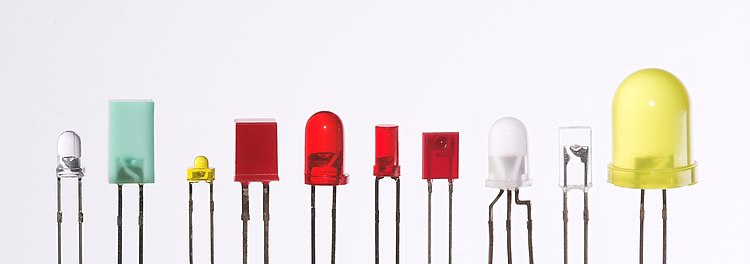
يتم إنتاج المصابيح في مجموعة متنوعة من الأشكال والأحجام. غالبًا ما يكون لون العدسة البلاستيكية هو نفس اللون الفعلي للضوء المنبعث ، ولكن ليس دائمًا. على سبيل المثال ، غالبًا ما يستخدم البلاستيك الأرجواني لمصابيح LED بالأشعة تحت الحمراء ، وتحتوي معظم الأجهزة الزرقاء على أغطية عديمة اللون. توجد بشكل عام مصابيح LED الحديثة عالية الطاقة مثل تلك المستخدمة للإضاءة والإضاءة الخلفية تكنولوجيا السطح حزم (SMT) (غير معروضة).
تصنع المصابيح في عبوات مختلفة لتطبيقات مختلفة. يمكن تعبئة تقاطعات LED مفردة أو قليلة في جهاز مصغر واحد لاستخدامه كمؤشر أو مصباح تجريبي. قد تتضمن مصفوفة LED دوائر تحكم داخل نفس الحزمة ، والتي قد تتراوح من المقاوم البسيط ، أو الوميض أو التحكم في تغيير اللون ، أو وحدة تحكم قابلة للعنونة لأجهزة RGB. سيتم تركيب الأجهزة عالية الطاقة التي ينبعث منها اللون الأبيض على أحواض حرارية وسيتم استخدامها للإضاءة. تتوفر شاشات العرض الأبجدية الرقمية بتنسيق نقطي أو شريطي على نطاق واسع. تسمح الحزم الخاصة بتوصيل مصابيح LED بالألياف الضوئية لروابط اتصال البيانات عالية السرعة.
مصغر
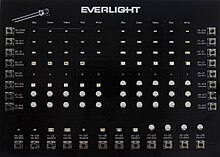
صورة مصغرة سطح جبل المصابيح في معظم الأحجام الشائعة. يمكن أن تكون أصغر بكثير من 5 التقليدية mm نوع المصباح LED ، يظهر في الزاوية اليسرى العليا.

صغير جدًا (1.6 × 1.6 × 0.35 مم) الأحمر والأخضر والأزرق سطح جبل حزمة مصغرة LED مع الذهب ربط الأسلاك تفاصيل.
هذه في الغالب عبارة عن مصابيح LED أحادية القالب تستخدم كمؤشرات ، وتأتي بأحجام مختلفة من 2 مم إلى 8 مم ، من خلال ثقب و سطح جبل الحزم.[114] تتراوح التصنيفات الحالية النموذجية من حوالي 1 مللي أمبير إلى أكثر من 20 مللي أمبير. تشكل مصابيح LED المتعددة المرفقة بشريط دعم مرن شكل ضوء بقيادة قطاع.[بحاجة لمصدر]
تتضمن أشكال العبوات الشائعة شكل دائري ، مع قبة أو قمة مسطحة ، مستطيل مع قمة مسطحة (كما هو مستخدم في عروض الرسم البياني الشريطي) ، ومثلث أو مربع مع قمة مسطحة. قد يكون التغليف واضحًا أو ملونًا لتحسين التباين وزاوية الرؤية. قد تحتوي أجهزة الأشعة تحت الحمراء على لون أسود لحجب الضوء المرئي أثناء تمرير الأشعة تحت الحمراء.[بحاجة لمصدر]
تم تصميم مصابيح LED عالية الإخراج للعرض في ضوء الشمس المباشر[بحاجة لمصدر]
5 V و 12 V LEDs هي مصابيح LED مصغرة عادية لها مقاومة سلسلة للتوصيل المباشر بـ 5 V أو 12 العرض الخامس.[بحاجة لمصدر]
قوة عالية

الصمامات الثنائية الباعثة للضوء عالية الطاقة المتصلة بقاعدة نجمية LED (لوكسون, لوميليدس)أنظر أيضا: إضاءة الحالة الصلبة, مصباح LEDو و الإدارة الحرارية لمصابيح LED عالية الطاقة
يمكن تشغيل مصابيح LED عالية الطاقة (HP-LEDs) أو مصابيح LED عالية الإخراج (HO-LEDs) في التيارات من مئات مللي أمبير إلى أكثر من أمبير ، مقارنة بعشرات مللي أمبير لمصابيح LED الأخرى. يمكن للبعض أن يصدر أكثر من ألف لومن.[115][116] يؤدى كثافات الطاقة حتى 300 واط / سم2 تم تحقيقه. Since overheating is destructive, the HP-LEDs must be mounted on a heat sink to allow for heat dissipation. If the heat from an HP-LED is not removed, the device fails in seconds. One HP-LED can often replace an incandescent bulb in a flashlight, or be set in an array to form a powerful مصباح LED.
Some well-known HP-LEDs in this category are the Nichia 19 series, Lumileds Rebel Led, Osram Opto Semiconductors Golden Dragon, and Cree X-lamp. As of September 2009, some HP-LEDs manufactured by Cree now exceed 105 lm/W.[117]
أمثلة على Haitz’s law—which predicts an exponential rise in light output and efficacy of LEDs over time—are the CREE XP-G series LED, which achieved 105 lm/W in 2009[117] and the Nichia 19 series with a typical efficacy of 140 lm/W, released in 2010.[118]
AC-driven
LEDs developed by Seoul Semiconductor can operate on AC power without a DC converter. For each half-cycle, part of the LED emits light and part is dark, and this is reversed during the next half-cycle. The efficacy of this type of HP-LED is typically 40 lm/W.[119] A large number of LED elements in series may be able to operate directly from line voltage. In 2009, Seoul Semiconductor released a high DC voltage LED, named as ‘Acrich MJT’, capable of being driven from AC power with a simple controlling circuit. The low-power dissipation of these LEDs affords them more flexibility than the original AC LED design.[120]
Application-specific variations
| هذا القسم يحتاج اقتباسات إضافية لـ التحقق. الرجاء المساعدة تحسين هذه المقالة بواسطة إضافة اقتباسات إلى مصادر موثوقة. مواد لم تنسبه الى مصدر يجوز الطعن وإزالتها. ابحث عن المصادر: “Light-emitting diode” – أخبار · الصحف · الكتب · مختص بمجال علمي · JSTOR (أكتوبر 2020) (تعرف على كيفية ووقت إزالة رسالة القالب هذه) |
وامض
Flashing LEDs are used as attention seeking indicators without requiring external electronics. Flashing LEDs resemble standard LEDs but they contain an integrated voltage regulator و أ multivibrator circuit that causes the LED to flash with a typical period of one second. In diffused lens LEDs, this circuit is visible as a small black dot. Most flashing LEDs emit light of one color, but more sophisticated devices can flash between multiple colors and even fade through a color sequence using RGB color mixing.
Bi-color
Bi-color LEDs contain two different LED emitters in one case. There are two types of these. One type consists of two dies connected to the same two leads مضاد لبعضهم البعض. Current flow in one direction emits one color, and current in the opposite direction emits the other color. The other type consists of two dies with separate leads for both dies and another lead for common anode or cathode so that they can be controlled independently. The most common bi-color combination is red/traditional green, however, other available combinations include amber/traditional green, red/pure green, red/blue, and blue/pure green.
RGB Tri-color
Tri-color LEDs contain three different LED emitters in one case. Each emitter is connected to a separate lead so they can be controlled independently. A four-lead arrangement is typical with one common lead (anode or cathode) and an additional lead for each color. Others, however, have only two leads (positive and negative) and have a built-in electronic controller.
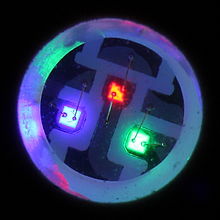
RGB-SMD-LED
RGB LEDs consist of one red, one green, and one blue LED.[121] By independently تعديل each of the three, RGB LEDs are capable of producing a wide color gamut. Unlike dedicated-color LEDs, however, these do not produce pure wavelengths. Modules may not be optimized for smooth color mixing.
Decorative-multicolor
Decorative-multicolor LEDs incorporate several emitters of different colors supplied by only two lead-out wires. Colors are switched internally by varying the supply voltage.
أبجدي رقمي

Composite image of an 11 × 44 LED matrix lapel name tag display using 1608/0603-type SMD LEDs. Top: A little over half of the 21 × 86 mm عرض. Center: Close-up of LEDs in ambient light. Bottom: LEDs in their own red light.
Alphanumeric LEDs are available in seven-segment, starburstو و dot-matrix شكل. Seven-segment displays handle all numbers and a limited set of letters. Starburst displays can display all letters. Dot-matrix displays typically use 5×7 pixels per character. Seven-segment LED displays were in widespread use in the 1970s and 1980s, but rising use of liquid crystal displays, with their lower power needs and greater display flexibility, has reduced the popularity of numeric and alphanumeric LED displays.
Digital RGB
Digital RGB addressable LEDs contain their own “smart” control electronics. In addition to power and ground, these provide connections for data-in, data-out, clock and sometimes a strobe signal. These are connected in a سلسلة ديزي. Data sent to the first LED of the chain can control the brightness and color of each LED independently of the others. They are used where a combination of maximum control and minimum visible electronics are needed such as strings for Christmas and LED matrices. Some even have refresh rates in the kHz range, allowing for basic video applications. These devices are known by their part number (WS2812 being common) or a brand name such as NeoPixel.
Filament
ان LED filament consists of multiple LED chips connected in series on a common longitudinal substrate that forms a thin rod reminiscent of a traditional incandescent filament.[122] These are being used as a low-cost decorative alternative for traditional light bulbs that are being phased out in many countries. The filaments use a rather high voltage, allowing them to work efficiently with mains voltages. Often a simple rectifier and capacitive current limiting are employed to create a low-cost replacement for a traditional light bulb without the complexity of the low voltage, high current converter that single die LEDs need.[123] Usually, they are packaged in bulb similar to the lamps they were designed to replace, and filled with inert gas to remove heat efficiently.
Chip-on-board arrays
Surface-mounted LEDs are frequently produced in chip on board (COB) arrays, allowing better heat dissipation than with a single LED of comparable luminous output.[124] The LEDs can be arranged around a cylinder, and are called “corn cob lights” because of the rows of yellow LEDs.[125]
Considerations for use
Power sources
المقال الرئيسي: LED power sources

Simple LED circuit with resistor for current limiting
The current in an LED or other diodes rises exponentially with the applied voltage (see معادلة شوكلي ديود), so a small change in voltage can cause a large change in current. Current through the LED must be regulated by an external circuit such as a constant current source to prevent damage. Since most common power supplies are (nearly) constant-voltage sources, LED fixtures must include a power converter, or at least a current-limiting resistor. In some applications, the internal resistance of small batteries is sufficient to keep current within the LED rating.[بحاجة لمصدر]
قطبية كهربائية
المقال الرئيسي: Electrical polarity of LEDs
Unlike a traditional incandescent lamp, an LED will light only when voltage is applied in the forward direction of the diode. No current flows and no light is emitted if voltage is applied in the reverse direction. If the reverse voltage exceeds the جهد الانهيار, a large current flows and the LED will be damaged. If the reverse current is sufficiently limited to avoid damage, the reverse-conducting LED is a useful noise diode.[بحاجة لمصدر]
السلامة والصحة
المؤكد blue LEDs and cool-white LEDs can exceed safe limits of the so-called blue-light hazard as defined in eye safety specifications such as “ANSI/IESNA RP-27.1–05: Recommended Practice for Photobiological Safety for Lamp and Lamp Systems”.[126] One study showed no evidence of a risk in normal use at domestic illuminance,[127] and that caution is only needed for particular occupational situations or for specific populations.[128] في عام 2006 ، اللجنة الكهرتقنية الدولية نشرت IEC 62471 Photobiological safety of lamps and lamp systems, replacing the application of early laser-oriented standards for classification of LED sources.[129]
While LEDs have the advantage over مصابيح فلورسنت, in that they do not contain الزئبق, they may contain other hazardous metals such as قيادة و الزرنيخ.[130]
In 2016 the الجمعية الطبية الأميركية (AMA) issued a statement concerning the possible adverse influence of blueish إنارة الشوارع على ال sleep-wake cycle of city-dwellers. Industry critics claim exposure levels are not high enough to have a noticeable effect.[131]
مزايا
- كفاءة: LEDs emit more lumens per watt than incandescent light bulbs.[132] The efficiency of LED lighting fixtures is not affected by shape and size, unlike fluorescent light bulbs or tubes.
- اللون: LEDs can emit light of an intended color without using any color filters as traditional lighting methods need. This is more efficient and can lower initial costs.
- Size: LEDs can be very small (smaller than 2 mm2[133]) and are easily attached to printed circuit boards.
- Warmup time: LEDs light up very quickly. A typical red indicator LED achieves full brightness in under a ميكروثانية.[134] LEDs used in communications devices can have even faster response times.
- Cycling: LEDs are ideal for uses subject to frequent on-off cycling, unlike incandescent and fluorescent lamps that fail faster when cycled often, or مصابيح التفريغ عالية الكثافة (HID lamps) that require a long time before restarting.
- Dimming: LEDs can very easily be dimmed either by pulse-width modulation or lowering the forward current.[135] This pulse-width modulation is why LED lights, particularly headlights on cars, when viewed on camera or by some people, seem to flash or flicker. This is a type of stroboscopic effect.
- Cool light: In contrast to most light sources, LEDs radiate very little heat in the form of IR that can cause damage to sensitive objects or fabrics. Wasted energy is dispersed as heat through the base of the LED.
- Slow failure: LEDs mainly fail by dimming over time, rather than the abrupt failure of incandescent bulbs.[136]
- Lifetime: LEDs can have a relatively long useful life. One report estimates 35,000 to 50,000 hours of useful life, though time to complete failure may be shorter or longer.[137] Fluorescent tubes typically are rated at about 10,000 to 25,000 hours, depending partly on the conditions of use, and incandescent light bulbs at 1,000 to 2,000 hours. العديد من وزارة الطاقة demonstrations have shown that reduced maintenance costs from this extended lifetime, rather than energy savings, is the primary factor in determining the payback period for an LED product.[138]
- Shock resistance: LEDs, being solid-state components, are difficult to damage with external shock, unlike fluorescent and incandescent bulbs, which are fragile.[139]
- Focus: The solid package of the LED can be designed to التركيز its light. Incandescent and fluorescent sources often require an external reflector to collect light and direct it in a usable manner. For larger LED packages انعكاس داخلي كامل (TIR) lenses are often used to the same effect. However, when large quantities of light are needed many light sources are usually deployed, which are difficult to focus or collimate towards the same target.
سلبيات
- Temperature dependence: LED performance largely depends on the ambient temperature of the operating environment – or thermal management properties. Overdriving an LED in high ambient temperatures may result in overheating the LED package, eventually leading to device failure. An adequate تقليل الحرارة is needed to maintain long life. This is especially important in automotive, medical, and military uses where devices must operate over a wide range of temperatures, and require low failure rates.
- Voltage sensitivity: LEDs must be supplied with a voltage above their threshold voltage and a current below their rating. Current and lifetime change greatly with a small change in applied voltage. They thus require a current-regulated supply (usually just a series resistor for indicator LEDs).[140]
- Color rendition: Most cool-white LEDs have spectra that differ significantly from a الجسم الأسود radiator like the sun or an incandescent light. The spike at 460 nm and dip at 500 nm can make the color of objects appear differently under cool-white LED illumination than sunlight or incandescent sources, due to metamerism,[141] red surfaces being rendered particularly poorly by typical phosphor-based cool-white LEDs. The same is true with green surfaces. The quality of color rendition of an LED is measured by the Color Rendering Index (CRI).
- Area light source: Single LEDs do not approximate a نقطه المصدر of light giving a spherical light distribution, but rather a lambertian توزيع. So, LEDs are difficult to apply to uses needing a spherical light field; however, different fields of light can be manipulated by the application of different optics or “lenses”. LEDs cannot provide divergence below a few degrees.[142]
- التلوث الضوئي: لان white LEDs emit more short wavelength light than sources such as high-pressure sodium vapor lamps, the increased blue and green sensitivity of scotopic vision means that white LEDs used in outdoor lighting cause substantially more sky glow.[120]
- Efficiency droop: The efficiency of LEDs decreases as the التيار الكهربائي يزيد. Heating also increases with higher currents, which compromises LED lifetime. These effects put practical limits on the current through an LED in high power applications.[143]
- Impact on wildlife: LEDs are much more attractive to insects than sodium-vapor lights, so much so that there has been speculative concern about the possibility of disruption to الشبكات الغذائية.[144][145] LED lighting near beaches, particularly intense blue and white colors, can disorient turtle hatchlings and make them wander inland instead.[146] The use of “Turtle-safe lighting” LEDs that emit only at narrow portions of the visible spectrum is encouraged by conservancy groups in order to reduce harm.[147]
- Use in winter conditions: Since they do not give off much heat in comparison to incandescent lights, LED lights used for traffic control can have snow obscuring them, leading to accidents.[148][149]
- Thermal runaway: Parallel strings of LEDs will not share current evenly due to the manufacturing tolerances in their forward voltage. Running two or more strings from a single current source may result in LED failure as the devices warm up. If forward voltage binning is not possible, a circuit is required to ensure even distribution of current between parallel strands.[150]
التطبيقات
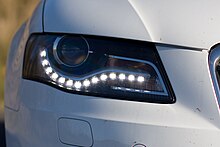
الاضواء النهاريه LEDs of an automobile
LED uses fall into four major categories:
- Visual signals where light goes more or less directly from the source to the human eye, to convey a message or meaning
- إضاءة where light is reflected from objects to give visual response of these objects
- Measuring and interacting with processes involving no human vision[151]
- Narrow band light sensors where LEDs operate in a reverse-bias mode and respond to incident light, instead of emitting light[152][153][154][155]
Indicators and signs
| هذا القسم لا استشهد أي المصادر. الرجاء المساعدة تحسين هذا القسم بواسطة إضافة اقتباسات إلى مصادر موثوقة. قد يتم الطعن في المواد غير المستعان بها و إزالة. (أكتوبر 2020) (تعرف على كيفية ووقت إزالة رسالة القالب هذه) |
ال low energy consumption, low maintenance and small size of LEDs has led to uses as status indicators and displays on a variety of equipment and installations. Large-area LED displays are used as stadium displays, dynamic decorative displays, and dynamic message signs on freeways. Thin, lightweight message displays are used at airports and railway stations, and as destination displays for trains, buses, trams, and ferries.
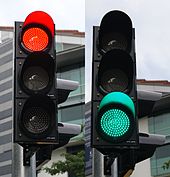
Red and green LED traffic signals
One-color light is well suited for إشارات المرور and signals, exit signs, emergency vehicle lighting, ships’ navigation lights, and LED-based Christmas lights
Because of their long life, fast switching times, and visibility in broad daylight due to their high output and focus, LEDs have been used in automotive brake lights and turn signals. The use in brakes improves safety, due to a great reduction in the time needed to light fully, or faster rise time, about 0.1 second faster[بحاجة لمصدر] than an incandescent bulb. This gives drivers behind more time to react. In a dual intensity circuit (rear markers and brakes) if the LEDs are not pulsed at a fast enough frequency, they can create a phantom array, where ghost images of the LED appear if the eyes quickly scan across the array. White LED headlamps are beginning to appear. Using LEDs has styling advantages because LEDs can form much thinner lights than incandescent lamps with عاكسات قطع مكافئ.
Due to the relative cheapness of low output LEDs, they are also used in many temporary uses such as glowsticks, throwies, and the photonic الغزل والنسيج Lumalive. Artists have also used LEDs for LED art.
إضاءة
المقال الرئيسي: مصباح LED
With the development of high-efficiency and high-power LEDs, it has become possible to use LEDs in lighting and illumination. To encourage the shift to المصابيح التي تقودها and other high-efficiency lighting, in 2008 the وزارة الطاقة الأمريكية خلق ال L Prize منافسة. ال فيليبس Lighting North America LED bulb won the first competition on August 3, 2011, after successfully completing 18 months of intensive field, lab, and product testing.[156]
Efficient lighting is needed for sustainable architecture. As of 2011, some LED bulbs provide up to 150 lm/W and even inexpensive low-end models typically exceed 50 lm/W, so that a 6-watt LED could achieve the same results as a standard 40-watt incandescent bulb. The lower heat output of LEDs also reduces demand on تكيف الأنظمة. Worldwide, LEDs are rapidly adopted to displace less effective sources such as المصابيح المتوهجة و CFLs and reduce electrical energy consumption and its associated emissions. Solar powered LEDs are used as أضواء الشوارع و في architectural lighting.
The mechanical robustness and long lifetime are used in automotive lighting on cars, motorcycles, and bicycle lights. LED street lights are employed on poles and in parking garages. In 2007, the Italian village of Torraca was the first place to convert its street lighting to LEDs.[157]
Cabin lighting on recent ايرباص و بوينغ jetliners uses LED lighting. LEDs are also being used in airport and heliport lighting. LED airport fixtures currently include medium-intensity runway lights, runway centerline lights, taxiway centerline and edge lights, guidance signs, and obstruction lighting.
LEDs are also used as a light source for DLP projectors, and to backlight شاشة LCD televisions (referred to as LED TVs) و حاسوب محمول يعرض. RGB LEDs raise the color gamut by as much as 45%. Screens for TV and computer displays can be made thinner using LEDs for backlighting.[158]
LEDs are small, durable and need little power, so they are used in handheld devices such as مشاعل. يؤدى الأضواء القوية أو camera flashes operate at a safe, low voltage, instead of the 250+ volts commonly found in زينون flashlamp-based lighting. This is especially useful in cameras on الهواتف المحمولة, where space is at a premium and bulky voltage-raising circuitry is undesirable.
LEDs are used for infrared illumination in رؤية ليلية uses including security cameras. A ring of LEDs around a كاميرا فيديو, aimed forward into a retroreflective خلفية, allows chroma keying في video productions.
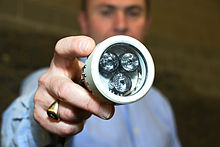
LED for miners, to increase visibility inside mines
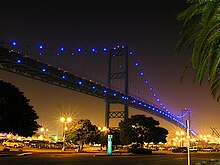
Los Angeles Vincent Thomas Bridge illuminated with blue LEDs
LEDs are used in mining operations, as cap lamps to provide light for miners. Research has been done to improve LEDs for mining, to reduce glare and to increase illumination, reducing risk of injury to the miners.[159]
LEDs are increasingly finding uses in medical and educational applications, for example as mood enhancement.[160] ناسا has even sponsored research for the use of LEDs to promote health for astronauts.[161]
Data communication and other signalling
أنظر أيضا: Li-Fi, fibre opticsو و Visible light communication
Light can be used to transmit data and analog signals. For example, lighting white LEDs can be used in systems assisting people to navigate in closed spaces while searching necessary rooms or objects.[162]
أجهزة الاستماع المساعدة in many theaters and similar spaces use arrays of infrared LEDs to send sound to listeners’ receivers. Light-emitting diodes (as well as semiconductor lasers) are used to send data over many types of الألياف البصرية cable, from digital audio over TOSLINK cables to the very high bandwidth fiber links that form the Internet backbone. For some time, computers were commonly equipped with إردا interfaces, which allowed them to send and receive data to nearby machines via infrared.
Because LEDs can cycle on and off millions of times per second, very high data bandwidth can be achieved.[163] لهذا السبب، Visible Light Communication (VLC) has been proposed as an alternative to the increasingly competitive radio bandwidth.[164] By operating in the visible part of the electromagnectic spectrum, data can be transmitted without occupying the frequencies of radio communications.
The main characteristic of VLC, lies on the incapacity of light to surpass physical opaque barriers. This characteristic can be considered a weak point of VLC, due to the susceptibility of interference from physical objects, but is also one of its many strenghts: unlike radio waves, light waves are confined in the encolsed spaces they are transmitted, which enforces a physical safety barrier that requires a receptor of that signal to have physical access to the place where the transmission is occurring.[164]
A promising applications of VLC lies on the Indoor Positioning System (IPS), an analogous to the GPS built to operate in enclosed spaces where the sattelite transmissions that allow the GPS operation are hard to reach. For instance, commercial buildings, shoppings malls, parking garages, as well as subways and tunnel systems are all possible applications for VLC-based indoor positioning systems. Additionally, once the VLC lamps are able to perform lighting at the same time as data transmission, it can simply occupy the installation of traditional single-function lamps.
Other applications for VLC involve communication between appliances of a smart home or office. With increasing إنترنت الأشياء-capable devices, connectivity through traditional radio waves might be subjected to interference.[165] However, light bulbs with VLC capabilities would be able to transmit data and commands for such devices.
Machine vision systems
المقال الرئيسي: رؤية الجهاز
رؤية الجهاز systems often require bright and homogeneous illumination, so features of interest are easier to process. LEDs are often used.
Barcode scanners are the most common example of machine vision applications, and many of those scanners use red LEDs instead of lasers. Optical computer mice use LEDs as a light source for the miniature camera within the mouse.
LEDs are useful for machine vision because they provide a compact, reliable source of light. LED lamps can be turned on and off to suit the needs of the vision system, and the shape of the beam produced can be tailored to match the system’s requirements.
Biological detection
The discovery of radiative recombination in Aluminum Gallium Nitride (AlGaN) alloys by مختبر أبحاث الجيش الأمريكي (ARL) led to the conceptualization of UV light emitting diodes (LEDs) to be incorporated in light induced ضوئي sensors used for biological agent detection.[166][167][168] في عام 2004 ، Edgewood Chemical Biological Center (ECBC) initiated the effort to create a biological detector named TAC-BIO. The program capitalized on Semiconductor UV Optical Sources (SUVOS) developed by the Defense Advanced Research Projects Agency (DARPA).[168]
UV induced fluorescence is one of the most robust techniques used for rapid real time detection of biological aerosols.[168] The first UV sensors were lasers lacking in-field-use practicality. In order to address this, داربا incorporated SUVOS technology to create a low cost, small, lightweight, low power device. The TAC-BIO detector’s response time was one minute from when it sensed a biological agent. It was also demonstrated that the detector could be operated unattended indoors and outdoors for weeks at a time.[168]
Aerosolized biological particles will fluoresce and scatter light under a UV light beam. Observed fluorescence is dependent on the applied wavelength and the biochemical fluorophores within the biological agent. UV induced fluorescence offers a rapid, accurate, efficient and logistically practical way for biological agent detection. This is because the use of UV fluorescence is reagent less, or a process that does not require an added chemical to produce a reaction, with no consumables, or produces no chemical byproducts.[168]
Additionally, TAC-BIO can reliably discriminate between threat and non-threat aerosols. It was claimed to be sensitive enough to detect low concentrations, but not so sensitive that it would cause false positives. The particle counting algorithm used in the device converted raw data into information by counting the photon pulses per unit of time from the fluorescence and scattering detectors, and comparing the value to a set threshold.[169]
The original TAC-BIO was introduced in 2010, while the second generation TAC-BIO GEN II, was designed in 2015 to be more cost efficient as plastic parts were used. Its small, light-weight design allows it to be mounted to vehicles, robots, and unmanned aerial vehicles. The second generation device could also be utilized as an environmental detector to monitor air quality in hospitals, airplanes, or even in households to detect fungus and mold.[170][171]
تطبيقات أخرى

LED costume for stage performers

LED wallpaper by Meystyle
The light from LEDs can be modulated very quickly so they are used extensively in الألياف البصرية و free space optics communications. هذا يتضمن وحدة التحكم عن بعد, such as for television sets, where infrared LEDs are often used. Opto-isolators use an LED combined with a الثنائي الضوئي أو phototransistor to provide a signal path with electrical isolation between two circuits. This is especially useful in medical equipment where the signals from a low-voltage المستشعر circuit (usually battery-powered) in contact with a living organism must be electrically isolated from any possible electrical failure in a recording or monitoring device operating at potentially dangerous voltages. An optoisolator also lets information be transferred between circuits that don’t share a common ground potential.
Many sensor systems rely on light as the signal source. LEDs are often ideal as a light source due to the requirements of the sensors. نينتندو وي‘s sensor bar uses infrared LEDs. Pulse oximeters use them for measuring oxygen saturation. Some flatbed scanners use arrays of RGB LEDs rather than the typical مصباح الفلورسنت الكاثود البارد as the light source. Having independent control of three illuminated colors allows the scanner to calibrate itself for more accurate color balance, and there is no need for warm-up. Further, its sensors only need be monochromatic, since at any one time the page being scanned is only lit by one color of light.
Since LEDs can also be used as photodiodes, they can be used for both photo emission and detection. This could be used, for example, in a شاشة لمس that registers reflected light from a finger or قلم.[172] Many materials and biological systems are sensitive to, or dependent on, light. Grow lights use LEDs to increase البناء الضوئي في النباتات,[173] and bacteria and viruses can be removed from water and other substances using UV LEDs for تعقيم.[91]
Deep UV LEDs, with a spectra range 247 nm to 386 nm, have other applications, such as water/air purification, surface disinfection, epoxy curing, free-space nonline-of-sight communication, high performance liquid chromatography, UV curing and printing, phototherapy, medical/ analytical instrumentation, and DNA absorption.[167][174]
LEDs have also been used as a medium-quality إشارة الجهد في الدوائر الإلكترونية. The forward voltage drop (about 1.7 V for a red LED or 1.2V for an infrared) can be used instead of a الصمام الثنائي زينر in low-voltage regulators. Red LEDs have the flattest I/V curve above the knee. Nitride-based LEDs have a fairly steep I/V curve and are useless for this purpose. Although LED forward voltage is far more current-dependent than a Zener diode, Zener diodes with breakdown voltages below 3 V are not widely available.
The progressive miniaturization of low-voltage lighting technology, such as LEDs and OLEDs, suitable to incorporate into low-thickness materials has fostered experimentation in combining light sources and wall covering surfaces for interior walls in the form of LED wallpaper.
- A large LED display behind a قرص الفارس
- عرض من سبعة أجزاء that can display four digits and points
- LED panel light source used in an experiment on نبات نمو. The findings of such experiments may be used to grow food in space on long duration missions.

البحث والتطوير
Key challenges
LEDs require optimized efficiency to hinge on ongoing improvements such as phosphor materials and النقاط الكمومية.[175]
The process of down-conversion (the method by which materials convert more-energetic photons to different, less energetic colors) also needs improvement. For example, the red phosphors that are used today are thermally sensitive and need to be improved in that aspect so that they do not color shift and experience efficiency drop-off with temperature. Red phosphors could also benefit from a narrower spectral width to emit more lumens and becoming more efficient at converting photons.[176]
In addition, work remains to be done in the realms of current efficiency droop, color shift, system reliability, light distribution, dimming, thermal management, and power supply performance.[175]
Potential technology
Perovskite LEDs (PLEDs)
A new family of LEDs are based on the semiconductors called perovskites. In 2018, less than four years after their discovery, the ability of perovskite LEDs (PLEDs) to produce light from electrons already rivaled those of the best performing OLEDs.[177] They have a potential for cost-effectiveness as they can be processed from solution, a low-cost and low-tech method, which might allow perovskite-based devices that have large areas to be made with extremely low cost. Their efficiency is superior by eliminating non-radiative losses, in other words, elimination of إعادة التركيب pathways that do not produce photons; or by solving outcoupling problem (prevalent for thin-film LEDs) or balancing charge carrier injection to increase the EQE (external quantum efficiency). The most up-to-date PLED devices have broken the performance barrier by shooting the EQE above 20%.[178]
In 2018, Cao et al. and Lin et al. independently published two papers on developing perovskite LEDs with EQE greater than 20%, which made these two papers a mile-stone in PLED development. Their device have similar planar structure, i.e. the active layer (perovskite) is sandwiched between two electrodes. To achieve a high EQE, they not only reduced non-radiative recombination, but also utilized their own, subtly different methods to improve the EQE.[178]
In Cao and his colleagues’ work, they targeted to solve the outcoupling problem, which is that the optical physics of thin-film LEDs causes the majority of light generated by the semiconductor to be trapped in the device.[179] To achieve this goal, they demonstrated that solution-processed perovskites can spontaneously form submicrometre-scale crystal platelets, which can efficiently extract light from the device. These perovskites are formed via the introduction of حمض أميني additives into the perovskite السلف حلول. In addition, their method is able to passivate perovskite surface عيوب and reduce nonradiative recombination. Therefore, by improving the light outcoupling and reducing nonradiative losses, Cao and his colleagues successfully achieved PLED with EQE up to 20.7%.[180]
In Lin and his colleague’s work, however, they used a different approach to generate high EQE. Instead of modifying the microstructure of perovskite layer, they chose to adopt a new strategy for managing the compositional distribution in the device——an approach that simultaneously provides high التلألؤ and balanced charge injection. In other words, they still used flat emissive layer, but tried to optimize the balance of electrons and holes injected into the perovskite, so as to make the most efficient use of the charge carriers. Moreover, in the perovskite layer, the crystals are perfectly enclosed by MABr additive (where MA is CH3نيو هامبشاير3). The MABr shell passivates the nonradiative defects that would otherwise be present perovskite crystals, resulting in reduction of the nonradiative recombination. Therefore, by balancing charge injection and decreasing nonradiative losses, Lin and his colleagues developed PLED with EQE up to 20.3%.[181]
Two-way LEDs
Devices called “nanorods” are a form of LEDs that can also detect and absorb light. They consist of a quantum dot directly contacting two semiconductor materials (instead of just one as in a traditional LED). One semiconductor allows movement of positive charge and one allows movement of negative charge. They can emit light, sense light, and collect energy. The nanorod gathers electrons while the quantum dot shell gathers positive charges so the dot emits light. When the voltage is switched the opposite process occurs and the dot absorbs light. By 2017 the only color developed was red.[182]





